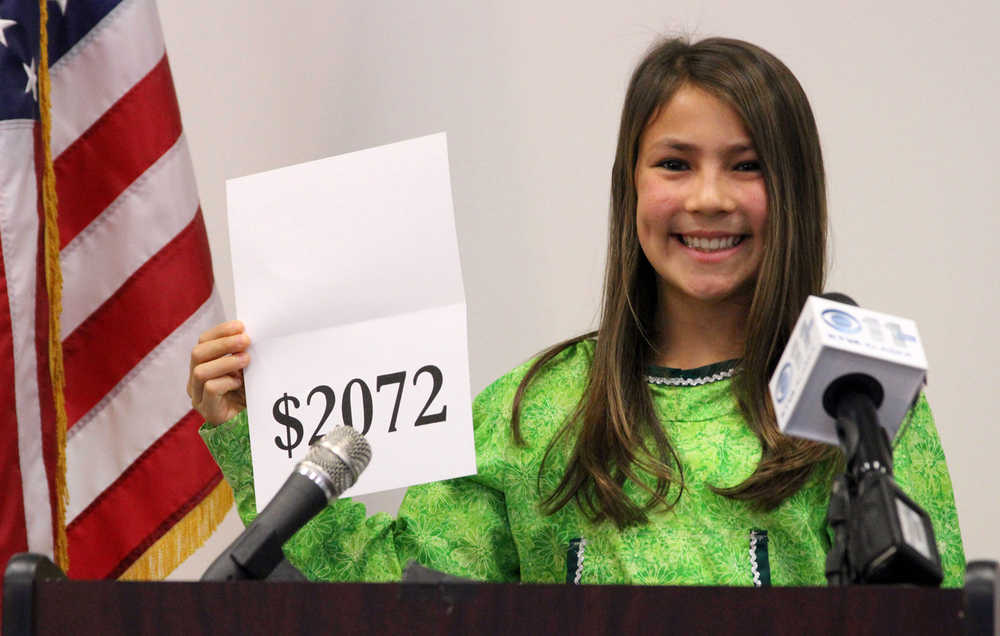ANCHORAGE — Oil prices are so low that they are hovering at benchmarks not seen in years, plunging oil-dependent Alaska into a crippling budget deficit. But the industry’s woes won’t affect how much the state’s oil investment account pays out to Alaskans, even though the government has been scrambling to pay the bills.
This year’s payout will be a record $2,072 for nearly every man, woman and child who lives in the 49th state. Last year’s check was $1,884, and the previous high was $2,069 in 2008.
State officials had seventh-grader Shania Sommer announce the dollar amount at a news conference Monday, with Gov. Bill Walker declaring, “This really is about the next generation.”
Here are questions and answers to the unique Alaska program that pays dividends to residents from the state’s resources:
Q. What is this payout?
A. After the discovery of oil on Alaska’s North Slope, a permanent fund was established in 1976 so all generations of Alaskans could benefit from the riches of the state’s natural resources. The state began distributing dividends to residents in 1982. If Alaskans have qualified for all of the payouts through last year, they would have collected more than $37,000 by now. But a good chunk of that so-called free money would have gone to the Internal Revenue Service in the form of federal taxes. Alaska has no state income tax. Altogether, more than $21.1 billion has been distributed to Alaskans.
Q: How does Alaska’s current budget crunch affect the payout?
A: The state is running on a $3.5 billion deficit, according to Walker’s office. It’s a situation exacerbated by low oil prices, and the state is using money from savings to help balance the budget. But the money in the permanent fund is in a separate account. It would take a simple majority of state lawmakers to tap into the fund’s earnings, but that could be the political kiss of death for a lawmaker willing to push the idea.
Officials said Monday that the fund faces new challenges, including proposals to adopt a new investment policy. A Permanent Fund Corp. meeting in Anchorage this month is open to the public, former longtime board member Eric Wohlforth said.
“I urge every Alaskan to become an informed investor in the fund, for their sake and the sake of the next generation,” he said.
Q: What do Alaskans have to do to qualify?
A: Not much, but they do have to endure the long winter. To get a check, residents must live in the state for a calendar year before they can sign up. Also eligible are young residents who were born in Alaska by the Dec. 31 deadline of the previous year. Last year, nearly 599,000 Alaskans were eligible.
Q: How does the payout formula work?
A: The dividend amount is based on a five-year average of investment earnings from the fund. During the past recession, Alaska wasn’t hit as hard as the Lower 48 states, but Permanent Fund Corp. suffered when markets plunged worldwide, hammering the diversified portfolio. The fund recovered and has a current value of $51.5 billion, compared with a balance of $29.9 billion in 2009.
Q: How do Alaskans typically spend the dough?
A: Some people treat themselves to recreational purchases like big-screen TVs, down payments on cars and vacations. For this fun-money category, businesses often take advantage of the desires of Alaskans and offer highly advertised dividend deals. You could even use the promise of handing over your check now as a down payment on a car.
Other residents treat it as serious money, socking it away in savings, catching up on bills or investing in college savings. Some residents give part of their dividend to charitable causes through the program “Pick. Click. Give.”
Q: How unique is Alaska?
A: Many nations have so-called sovereign wealth funds, with Norway’s oil fund among the wealthiest. Several U.S. states also have similar funds, including North Dakota, which launched its Legacy Fund earlier this decade following an oil boom. But unlike Alaska, which distributes proceeds from the fund to residents, North Dakota lawmakers can’t touch the fund until 2017 — and only if two-thirds of legislators vote to withdraw cash.
Associated Press writer Mark Thiessen contributed to this report from Anchorage.

